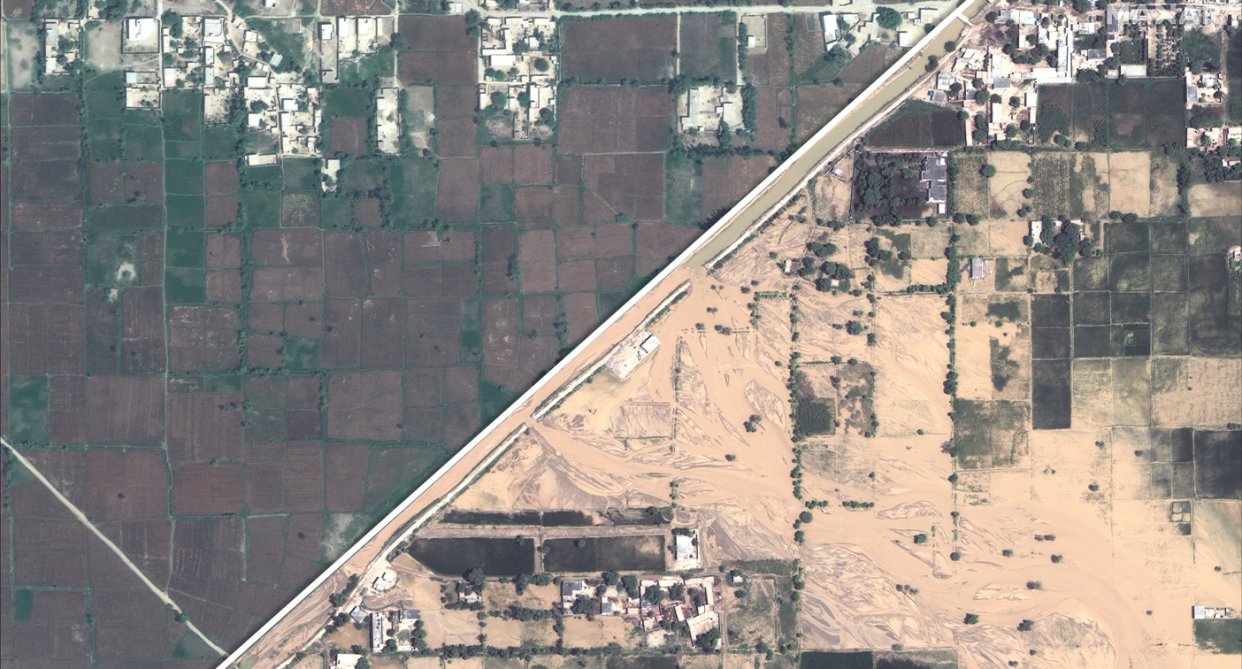Satellite images show extent of Pakistan's 'colossal crisis'
Satellite images highlight the impact of the torrential deluge which has submerged a third of Pakistan in floodwaters.
Focused above the Punjab province of Gudpur, they show what the United Nations has called an “unprecedented climate catastrophe".
Officials believe more than 1100 people have died in Pakistan and 33 million have been impacted during the disaster which began in June.

Crops and livestock have been killed and many towns are isolated because roads and bridges are damaged, complicating the task of aid delivery.
On Tuesday, UN Secretary-General Antonio Guterres launched an appeal to raise $160 million to help the country, which he described as “awash in suffering”.
“The Pakistani people are facing a monsoon on steroids — the relentless impact of epochal levels of rain and flooding,” he said.
Urging the world to “respond quickly and collaboratively to this colossal crisis”, Mr Guterres used his televised speech to focus on the ongoing destruction caused by climate change.
Let’s stop sleepwalking towards the destruction of our planet by climate change. Today, it’s Pakistan. Tomorrow, it could be your country.UN Secretary-General Antonio Guterres
Pakistan faces multi-billion dollar flood damage bill
Facing a US$10 billion ($14.5 billion) damage bill, Pakistan’s Prime Minister Shehbaz Sharif has called for the US$160 million ($230 million) appeal to be "multiplied rapidly".
He warned without assistance his nation could experience a food shortage and pledged “every penny” will be spent with transparency.
Commentators have noted Pakistan is responsible for just one per cent of global greenhouse gas emissions, but is in the top 10 countries vulnerable to climate change.
With Pacific island nations also facing a grim future due to global heating, Fiji’s Prime Minister Frank Bainimarama took to Twitter, calling for climate action.
“Let's be clear: the Pakistani people did not do this to Pakistan –– we all did, and the high-emitting nations are most responsible,” he said.
“Unless we end our species' addiction to fossil fuels, every country in the world will remain in the crosshairs of the climate breakdown.”
Australia one of the world's largest fossil fuel exporters
Australia’s role as the third largest exporter as fossil fuels has caused concern across the region, with some linking it to strained relations with climate change vulnerable Pacific nations.
While the Albanese government has set an ambitious emissions reduction target for 2030, it has refused to rule out approving new fossil fuel projects.
Last week, resources minister Madeliene King controversially announced the Commonwealth would open open 46,000 square kilometres for offshore oil and gas exploration.
The United Nations has warned replacing fossil fuels with renewable energy is key to reaching net zero by 2050.
with Reuters
Do you have a story tip? Email: newsroomau@yahoonews.com.
You can also follow us on Facebook, Instagram, TikTok and Twitter and download the Yahoo News app from the App Store or Google Play.



